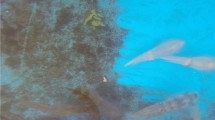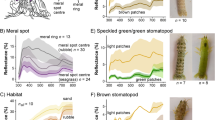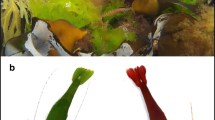Abstract
Cephalopods (octopus, squid and cuttlefish) are known for their camouflage. Cuttlefish Sepia officinalis use chromatophores and light reflectors for color change, and papillae to change three-dimensional physical skin texture. Papillae vary in size, shape and coloration; nine distinct sets of papillae are described here. The objective was to determine whether cuttlefish use visual or tactile cues to control papillae expression. Cuttlefish were placed on natural substrates to evoke the three major camouflage body patterns: Uniform/Stipple, Mottle and Disruptive. Three versions of each substrate were presented: the actual substrate, the actual substrate covered with glass (removes tactile information) and a laminated photograph of the substrate (removes tactile and three-dimensional information because depth-of-field information is unavailable). No differences in Small dorsal papillae or Major lateral mantle papillae expression were observed among the three versions of each substrate. Thus, visual (not tactile) cues drive the expression of papillae in S. officinalis. Two sets of papillae (Major lateral mantle papillae and Major lateral eye papillae) showed irregular responses; their control requires future investigation. Finally, more Small dorsal papillae were shown in Uniform/Stipple and Mottle patterns than in Disruptive patterns, which may provide clues regarding the visual mechanisms of background matching versus disruptive coloration.




Similar content being viewed by others
References
Aristotle (1910) Historia Animalium. Clarendon Press, Oxford
Barbosa A, Florio CF, Chiao C-C, Hanlon RT (2004) Visual background features that elicit mottled body patterns in cuttlefish, Sepia officinalis. Biol Bull 207:154
Barbosa A, Mäthger LM, Chubb C, Florio C, Chiao C-C, Hanlon RT (2007) Disruptive coloration in cuttlefish: a visual perception mechanism that regulates ontogenetic adjustment of skin patterning. J Exp Biol 210:1139–1147
Barbosa A, Mäthger LM, Buresch KC, Kelly J, Chubb C, Chiao C-C, Hanlon RT (2008) Cuttlefish camouflage: the effects of substrate contrast and size in evoking uniform, mottle or disruptive body patterns. Vis Res 48:1242–1253
Bilecenoglu M, Taşkavak E, Kunt KB (2002) Range extension of three lessepsian migrant fish (Fistularia commersoni, Sphyraena flavicauda, Lagocephalus suezensis) in the Mediterranean Sea. J Mar Biol Assoc U K 82:525–526
Boal JG, Ni JN (1996) Ventilation rate of cuttlefish, Sepia officinalis, in response to visual stimuli. Veliger 39:342–347
Burr DC, Morrone MC, Spinelli D (1989) Evidence for edge and bar detectors in human vision. Vis Res 29:419–431
Chiao C-C, Hanlon RT (2001a) Cuttlefish camouflage: visual perception of size, contrast and number of white squares on artificial substrata initiates disruptive coloration. J Exp Biol 204:2119–2125
Chiao C-C, Hanlon RT (2001b) Cuttlefish cue visually on area—not shape or aspect ratio—of light objects in the substrate to produce disruptive body patterns for camouflage. Biol Bull 201:269–270
Chiao C-C, Kelman EJ, Hanlon RT (2005) Disruptive body patterning of cuttlefish (Sepia officinalis) requires visual information regarding edges and contrast of objects in natural substrate backgrounds. Biol Bull 208:7–11
Coll J, Linde M, García-Rubies A, Riera F, Grau AM (2004) Spear fishing in the Balearic Islands (west central Mediterranean): species affected and catch evolution during the period 1975–2001. Fish Res 70:97–111
Cott HB (1940) Adaptive coloration in animals. Methuen, London
Cuthill IC, Stevens M, Sheppard J, Maddocks T, Párraga CA, Trosclanko TS (2005) Disruptive coloration and background pattern matching. Nature 434:72–74
de Sylva DP (1963) Systematics and life history of the great barracuda Sphyraena barracuda (Walbaum). In: Studies in tropical oceanography, vol 1. Institute of Marine Science, University of Miami Press, Miami
de Sylva DP (1990) Sphyraenidae. CLOFETA 2:860–864
Hanlon RT (2007) Cephalopod dynamic camouflage. Curr Biol 17:R400–R405
Hanlon RT, Messenger JB (1988) Adaptive coloration in young cuttlefish (Sepia officinalis L.): the morphology and development of body patterns and their relation to behaviour. Philos Trans R Soc Lond B Biol Sci 320:437–487
Hanlon RT, Messenger JB (1996) Cephalopod behaviour. Cambridge University Press, Cambridge
Hanlon RT, Chiao C-C, Mäthger LM, Barbosa A, Buresch KC, Chubb C (2009) Cephalopod dynamic camouflage: bridging the continuum between background matching and disruptive coloration. Philos Trans R Soc B 364:429–437
Holmes W (1940) The colour changes and colour patterns of Sepia officinalis L. Proc Zool Soc Lond A 110:2–35
Kelman EJ, Baddeley RJ, Shohet AJ, Osorio D (2007) Perception of visual texture and the expression of disruptive camouflage by the cuttlefish, Sepia officinalis. Proc R Soc Lond B Biol Sci 274:1369–1375
Kelman EJ, Osorio D, Baddeley RJ (2008) A review of cuttlefish camouflage and object recognition and evidence for depth perception. J Exp Biol 211:1757–1763
Kier WM, Messenger JB, Miyan JA (1985) Mechanoreceptors in the fins of the cuttlefish, Sepia officinalis. J Exp Biol 119:369–373
King AJ, Adamo SA (2006) The ventilatory, cardiac and behavioral responses of resting cuttlefish (Sepia officinalis L.) to sudden visual stimuli. J Exp Biol 209:1101–1111
Langridge KV (2006) Symmetrical crypsis and asymmetrical signalling in the cuttlefish Sepia officinalis. Proc R Soc Lond B Biol Sci 273:959–967
Marshall NJ, Messenger JB (1996) Colour-blind camouflage. Nature 382:408–409
Mäthger LM, Barbosa A, Miner S, Hanlon RT (2006) Color blindness and contrast perception in cuttlefish (Sepia officinalis) determined by a visual sensorimotor assay. Vis Res 46:1746–1753
Mäthger LM, Chiao C-C, Barbosa A, Buresch KC, Kaye S, Hanlon RT (2007) Disruptive coloration elicited on controlled natural substrates in cuttlefish, Sepia officinalis. J Exp Biol 210:2657–2666
Messenger JB (2001) Cephalopod chromatophores: neurobiology and natural history. Biol Rev Camb Philos Soc 76:473–528
Osorio D, Srinivasan MV (1991) Camouflage by edge enhancement in animal coloration patterns and its implications for visual mechanisms. Proc R Soc Lond B Biol Sci 244:81–85
Petrakis G, Stergiou KI (1995) Weight-length relationships for 33 fish species in Greek waters. Fish Res 21:465–469
Porter HT, Motta PJ (2004) A comparison of strike and prey capture kinematics of three species of piscivorous fishes: Florida gar (Lepisosteus platyrhincus), redfin needlefish (Strongylura notata) and great barracuda (Sphyraena barracuda). Mar Biol 145:989–1000
Randall JE, Randall HA (1960) Examples of mimicry and protective resemblance in tropical marine fishes. Bull Mar Sci Gulf Caribb 10:444–480
Shohet AJ, Baddeley RJ, Anderson JC, Kelman EJ, Osorio D (2006) Cuttlefish responses to visual orientation of substrates, water flow and a model of motion camouflage. J Exp Biol 209:4717–4723
Shohet AJ, Baddeley RJ, Anderson JC, Osorio D (2007) Cuttlefish camouflage: a quantitative study of patterning. Biol J Linn Soc Lond 92:335–345
Stevens M, Cuthill IC, Windsor AMM, Walker HJ (2006) Disruptive contrast in animal camouflage. Proc R Soc Lond B Biol Sci 273:2433–2438
Thayer GH (1909) Concealing-coloration in the animal kingdom. An exposition of the laws of disguise through color and pattern: being a summary of Abbott H. Thayer’s discoveries. The Macmillan Company, New York
Acknowledgments
Special thanks to Liese Siemann, Douglas Engel and the Animal Care Staff at the Marine Resources Center for their diligent care of the cuttlefish during these experiments. Thanks to Michael Dacey for Fig. 1a, Roy Caldwell for Fig. 4a and Fred Bavendam for Fig. 4b and d. We are also grateful to Jean Boal and Charles Chubb for advice on statistics and to Kendra C. Buresch and C. C. Chiao for helpful suggestions throughout this project. JJA would like to thank her family for their support. AB is grateful for funding from POCI 2010 and Fundo Social Europeu through the Fundação para a Ciência e a Tecnologia, Portugal. This research was funded in part by the Sholley Foundation and ONR (grant N00014-06-1-0202). We are also grateful to two anonymous reviewers for their helpful comments.
Author information
Authors and Affiliations
Corresponding author
Rights and permissions
About this article
Cite this article
Allen, J.J., Mäthger, L.M., Barbosa, A. et al. Cuttlefish use visual cues to control three-dimensional skin papillae for camouflage. J Comp Physiol A 195, 547–555 (2009). https://doi.org/10.1007/s00359-009-0430-y
Received:
Revised:
Accepted:
Published:
Issue Date:
DOI: https://doi.org/10.1007/s00359-009-0430-y




